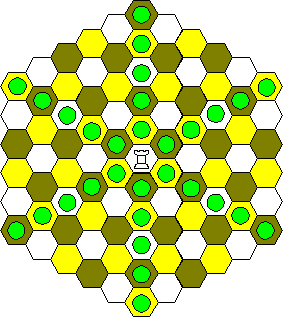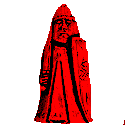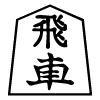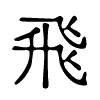Piececlopedia: Rook
Historical notes
Except for gaining the ability to castle, the Rook has remained the same since Chaturanga, which is widely regarded as the first form of Chess. This piece was originally known as a chariot. According to Duncan Forbes, chariots in Sanskrit were called "Roka" or "Ratha." (The History of Chess, 1860, Page 38) According to H.J.R. Murray, its original name was ratha, which is Sanskrit for chariot. He notes that this is pronounced răt-ha, not rath-a. (A History of Chess, 1913, "Note on the Transliteration of Sakskrit, Persian, and Arabic Words", Page 19) Notably, the piece is known by names meaning chariot in Chinese Chess and Korean Chess and as Flying Chariot (Hisha) in Shogi, the Japanese form of Chess, and each of these use the 車 pictograph for a chariot.
When the Persians got Chess from India, they called it a rukh. With regard to the word rukh, Forbes wrote in 1860, "The latter term, as well as our own Rook, are evidently derived from the Sanskrit Roka; although neither the Persians nor ourselves, in all probability, have ever known or thought of its original meaning. Sir William Jones derives the Persian Rukh from the Sanskrit “Ratha,” a chariot, pronounced Roth in Bengali. This derivation is inadmissible for two reasons; in the first place it is too far-fetched; and, secondly, the word Ratha is never mentioned in the ancient account of the Chaturanga." (Page 40-41)
But Murray claimed, "There can be no doubt that the chess-term Rukh simply meant chariot" (A History of Chess, 1913, Chapter VIII. "Chess in Persia Under the Sasanians", Page 160) However, he says further in the same paragraph, "Although rukh has never been the ordinary word for chariot in Persian, there is some evidence to show that it did bear that meaning both in Persian and Arabic." (Page 160). He cites Vuller's Persian Lexicon as saying that araba, the common Arabic word for chariot, was another word for rukh. He also cites Arabic-Latin glossaries in which rukhkh means chariot and Spanish glossaries indicating that "the word rukhkh was in common use among the Moors in Spain in the sense of chariot." Since this evidence suggests that even the Arabs knew the piece was a chariot and used the Persian word for the piece to mean chariot, this also stands as evidence that rukh was a Persian word for chariot. Additionally, Davidson cites the Burhani-Qati, a Persian dictionary that gives the meaning of chariot to rukh. (Davidson, A Short History of Chess, 1949, Page 46) However, the Encyclopedia Iranica's article on BORHĀN-E QĀṬEʿ questions its reliability.
Davidson suggests that this word originally referred to a soldier or hero, and that it acquired the meaning of chariot only by extension, as in a chariot driver being the hero of a battle. But Murray points out that no one has shown that rukh was ever used where one would expect the usual Persian word for hero. Murray rejects the theory that it meant hero and maintained that it meant chariot.
When the Arabs learned Chess from the Persians, they kept the name rukh. As indicated above, they may have understood this to mean chariot. However, Davidson cites the Encyclopedia of Islam as saying that the rukh in chess meant the "monstrous bird of that name." But he also claims that the encyclopedia is wrong, because it is an adaptation of a Persian word, and rukh never meant bird in Persian. (Davidson, A Short History of Chess, 1949, Page 45) Davidson may be mistaken about this, as the Wikipedia page on the mythical bird known in English as a Roc gives ruḵ as its Persian name and mentions that rukh is a common Romanization of this name. Additionally, Davidson says the Arabic portrayal of the piece with two projections "was a symbol of the two-headed bird, for whether the Arabs derived the word from the name of the bird or whether they simply carried over the Persian word for 'hero' or 'chariot,' the fact that their mythology did inclue a two-headed rukh made such a representation obvious." (Davidson, Loc 635 of 2865) When looking for references to a two-headed roc, though, the oldest reference I found was a 1958 movie called The 7th Voyage of Sinbad. While the movie poster does show a two-headed roc, my search through the story of Sinbad in the Arabian Nights did not turn up any description of the roc as having two heads. Since Davidson wrote in 1949, his reference of a two-headed roc would be even earlier.
When the piece made its way to Europe, it became common to represent it as some kind of tower, similar to how it is now portrayed in the Staunton set. While some have attributed this to a tower being carried on the back of an elephant in some old pieces, this was not the same piece. Duncan Forbes accounts for this by the linguistic similarity between the name and Italian words for fortress. With the explanation just mentioned in mind, he says,
Is it not much more likely, then, that the Italians were the first that brought the figure of the tower on the board — not from the “Elephant and Castle,” but simply because the word rocca or rocco does mean a castle or fortress in their language? (The History of Chess, 1860, Page 161)
Indeed, rocca does mean fortress in Italian. At that time, mobile towers were popular instruments of war. (The Dabbabah is another Chess piece named after this mobile tower.) This led to the tradition of calling the piece a tower. It was called torre in Spanish, tour in French, Toren in Dutch, and Turm in German. English merely tranliterated rukh into Rook, but even English speakers began representing the piece as a tower, and many English speakers frequently call the piece a Castle.
Movement
The Rook moves an arbitrary number of spaces in any orthogonal direction. It may not pass over occupied spaces, and it ends its move by occupying an empty space or by capturing an enemy piece.
Movement Diagrams
|
|

|
Vocabulary: Orthogonal
The Rook moves orthogonally. This is movement in a straight line along a series of spaces connected by shared sides. When any two spaces share a common side, they are said to be orthogonally adjacent. On a regular chessboard, orthogonal movement is vertical and horizontal. On a hexagonal chessboard, two orthogonal lines will be slanted, and the other will be vertical or horizontal, depending on the orientation of the board. In the diagram of a hexagonal board shown just above, orthogonal movement passes through the even hours of a clock face. This board has a vertical orientation. With a horizontal orientation, orthogonal movement would pass through the odd hours on a clock face.
Alternate Images
Click on an image to view the full piece set it belongs to.
Chess
|
Shogi
Xiangqi
|
References
Davidson, Henry A. A Short History of Chess, 1949.
This is an item in the Piececlopedia: an overview of different (fairy) chess pieces.
Written by Fergus Duniho and Hans Bodlaender. Square Diagram by Ben Good.
WWW page created: September 9, 1998.




